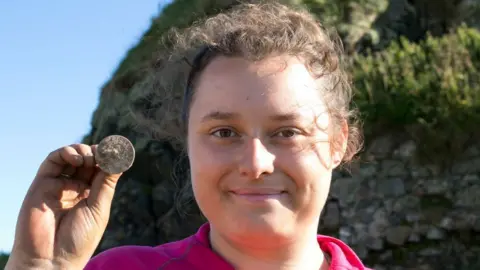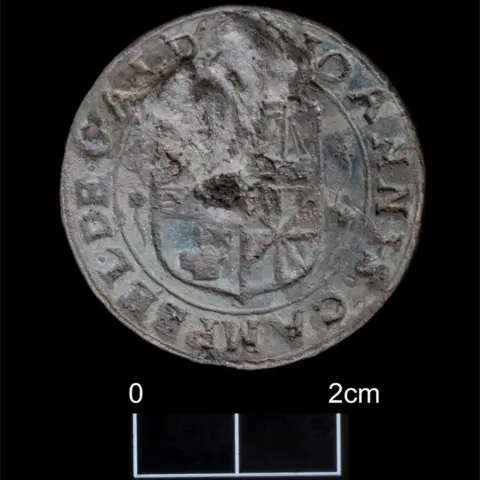Ancient clan seal found in castle ruins
 BBC
BBCA clan seal dating from the bitter feud between the Campbells and MacDonalds has been found in ruins on an island off the west coast of Scotland.
The 425-year-old seal, which bears the name Sir John Campbell of Cawdor, was found under a collapsed wall at Dunyvaig Castle on the Isle of Islay.
The artefact, which was used to sign and seal legal documents, is dated 1593 and bears the initials DM.
It was uncovered by a team of archaeologists working at the site.

The Campbell and MacDonald clans fought over Dunyvaig in the early 17th Century, with a series of sieges and bombardments of the castle until the Campbells finally won.
The circular disc, made of lead, was found buried below mounds of rubble from a collapsed defensive wall.
It carries the inscription IOANNIS CAMPBELL DE CALDER, which was the original spelling of Cawdor, and also carries the Cawdor coat of arms with a galley-ship and a stag.
The seal is thought to have belonged to Cawdor, who lived between 1576 and 1642, and who occupied the castle in 1615.
 Isla Heritage
Isla HeritageUniversity of Reading student Zoë Wiacek, who found the seal, said everyone on the dig became excited when it was uncovered.
She said: "I removed a piece of rubble and it was just sitting there on the ground.
"I immediately knew it was an important find, but had no idea what it was. I called over my trench supervisor, and when it was lifted, the soil fell away to show the inscription."

The excavation is being carried out by Islay Heritage and the University of Reading in a bid to learn more about the history of Dunyvaig.
Dr Darko Maričević, who is directing the excavation, said: "This is a remarkable find. Not only is it a beautiful and well-preserved object, but it comes from the floor of a building that we can now confidently date to the Campbell occupation.
"So buried below this floor, we will have the story of the MacDonald's - the Lords of the Isles - to reveal."

Roddy Regan, of Kilmartin Museum in Lochgilphead, added: "Seals are extremely rare finds.
"This discovery conjures up an image of a Campbell garrison fleeing from the castle when under attack, dropping and losing one of their most precious items, or maybe the seal had once been hidden within a wall niche and long forgotten.
"Perhaps the raid was in 1646, when Alasdair MacColla, a descendent of the MacDonalds, retook the castle and installed his elderly father, Colla Ciotach to defend it.
"The castle was immediately besieged again. We may have Colla Ciotach's hasty defences in the form of turf walls built above the already ruined stone walls of Dunyvaig, before he was forced to surrender in 1647 and then hanged from the castle walls."
The exact date of the original construction of Dunyvaig Castle is unknown, although archaeologists believe there is the possibility of the remains of an earlier settlement on the site, dating from Medieval or even prehistoric times.
The site is currently being excavated as part of an ongoing project. The current dig is due to conclude on Friday.
